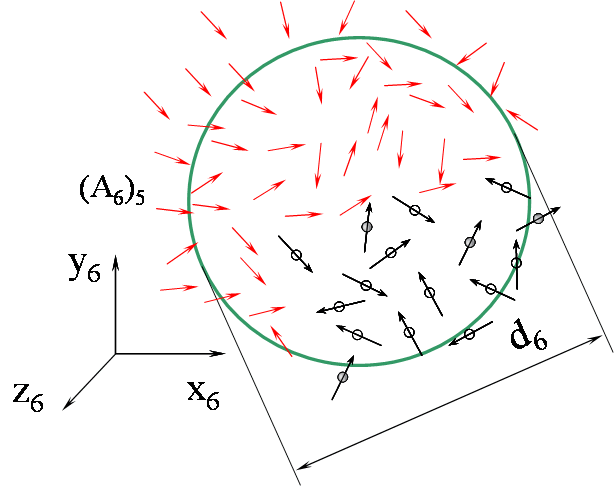
The Annals of Frontier and Exploratory Science
Vladi S. Travkin
Hierarchical Scaled Physics and Technologies (HSPT), Rheinbach, Germany, Denver, CO, USA
=========================================================================
In this article we would like to treat and talk about the Many-body problem under a different angle as it is in general mainly going down to astronomy point of view and make the HS physics based explanation of the sense and roots.
In the schools and universities already for many decades professors could and actually should easily and honestly saying to students that neither Lagrange in XVIII nor later Hamilton in XIX couldn't suggest, after Newton and other creators of point-mass', that there were any mathematics and physics to do some integrations of forces and effects in the behavior of VOLUMETRIC bodies, particles unless to proclaim them all as the point-mass' (PM) and do the integration by just summation of components (seems for a volume), terms related to each of the body, particle, etc.
These numerous "magnificent" theories of COHP with Lagrangians and Hamiltonians were developed further up from XVIII century desperate point-mass particles to the large, largest volumes of almost useless and wrongly explored theories on potential and kinetic energy particle "drives."
But now why professors are lying to students that there are the best and natural, the only ways to do the integration in particulate systems are through the use of Lagrangians and Hamiltonians by the simple summation of terms in equations for the effect?
Because being honest then professors should disclose to students something about the whole great fields in physics and math - the HSP that now on after 1967-80s using it students can try to do the integration of particle's effects correctly and with surprises?
Because the point-mass' in Lagrangians and Hamiltonians are fictitiously the physical objects. Professors never told on this ?

Attention students and professionals - these arrows are not the physical particles, they are the "point-mass-velocity" objects. Meanwhile, material points should have no visibility in physics in opposite to images that they are drawn in COHP as the dark-black circles. Points are the invisible and mathematical only objects. It is the habitual images made by mathematicians as the small dark-black circles just to designate and to see the location of Mathematical Invisible Points. But mathematicians never accept the points as the different objects than the designation of their location in the 3D Discrete Cartesian coordinate system.
Well, may be the part of mathematicians and crazy physicists that are believing in fashioned by great mathematicians at the beginning of XX, still wrong idea that point-mass particles can "torsion" inside the matter - see analysis in our "Torsion" or Spinning (Rotation) Physics Scaled (SPS). Mathematical point can "torsion" inside the mathematical 3D Discrete Dimensions Continuous space (mathematicians can force it making this by pure imagination) - but not the Physical point-mass, for that it needs to have the volume, no matter how small. And the major thing is that our Physical world-space (Universe) is the Broken Polyphase world-space.
That operation is from the prohibited in COHP the spiritual "parallel" world features, while still inside of the "parallel" world. They did and do not understand this.
That physicists of the beginning of XX century accepted the identity of these small black circles as the material objects namely sub-atomic particles -- meaning those are not only the location points in the Cartesian coordinate system.
They had no physics of Heterogeneous systems, media and had no
mathematics treating simultaneously the few phases or Heterogeneous
media processes. Those appeared only after the WWII in 1950s-60s.
The shown below drawings on C.Davisson and L.Germer experiment in our collection in the paper "Spinning or "Torsion" Mechanics in "Homogeneous" Media? Is it Possible?"
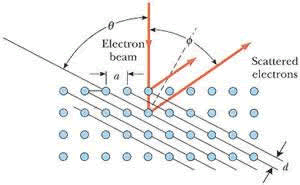
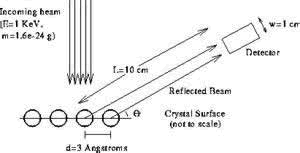
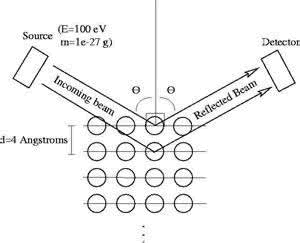
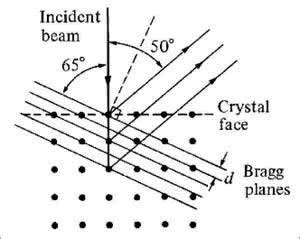
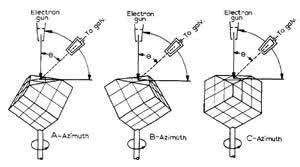
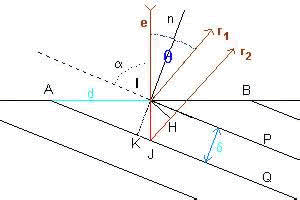
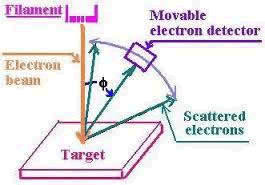
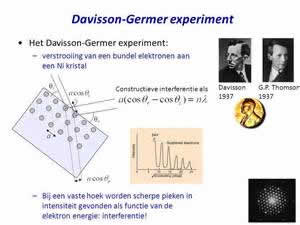
Fig. 3 Figures in the sequence that we show from the internet are reflecting, giving the schemes, the only existing interpretation in COH physics of Davisson -- Germer experiment. No one shows the wave creation from the Points-Dots - and how it can be done?
and everyone's other picture on this and other atomic and sub-atomic experiments published on the paper and in the internet all they have been done based on COHP collection of myths about sub-atomic particles and their "legitimate" images for students and public.
Also - Where are the waves? Any student asking the questions about this?"
So - correctly these invisible points-mass' should be designated as the arrows, but not with deception - as the black small circles that reminds and cheats student about the real material with volume particles no matter of what size.
We are sure this substitution of images was made on this
purpose - to cause students thinking that these images of
black circles are the real volumetric small sub-atomic
particles - while they are not presented in such a way in COHP.
Contrary to just points - the real sub-atomic particles have visibility - so far with not enough experimental spatial resolutions- still coming improvements, volume (whatever of size), and some kind of bounding surface.
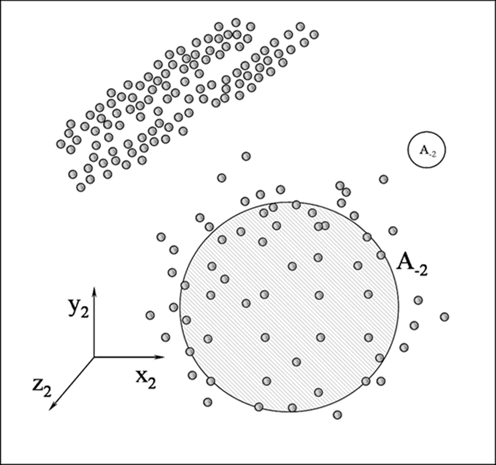
That is why we can and should abandon the "point-particle"
as the great (one of the greatest in XX century) conjecture,
the myth in physics with its mythical mathematical "duality" for
sub-atomic particles, and transfer the focus of education and
technical developments to the Polyphase-Polyscale description
of physical phenomena at sub-atomic and other scales and
generally around of us in nature and in technologies.
Previous, of XIX-XX physics of a One-Scale-One-Phase (OSOP) accepted phenomena was created as the one-scale Homogeneous matter physics because there were no tools, parts in mathematics and physics for Polyphase-Polyscale-Polyphysics (3P) treatments of Heterogeneous media, system, processes, devices, in technical applications of physical laws, in technologies.
Those almost exclusively, including and the Heterogeneous aether, are the Heterogeneous and Polyscale, but not Homogeneous and One-scale systems.
Now it is obvious that in the 3D Discrete Dimension (Cartesian) spatial materialization of our physical world we better use and should distinguish roughly the 3 tied, interconnected systems of Many-body (particles or really bodies) physical material realities.
1. Sub-atomic Particle Systems (SaPS).
These systems treatment and methods should follow Physics 2, HSP already obtained and developed many specific understandings and approaches. Because in COH physics many things and concepts are just conjectures and great simplifications that had been made partially due to the lack or complete absence of methods, under-development of physics itself. Just like that. See this website many sections-sciences with detailed explanations.
For example, when there are the Many-body problems arisen in SaPS - then they should not be addressed with COHP understanding and Hamiltonian summations of artificial Local (locally obtained dependencies) effects and terms in the equations, but use (apply) the 3P methods and equations.
Yes, those are much more complex and difficult for analysis and solution or simulation - but we are not in the XIX and need to stop using the more computers power for fancy tasks - like "forecasting" of nuclear winter or weather warming scams. All using the inadequate physics, etc.
2. Atoms and Small Molecules Systems (ASMS).
These systems are even more problematic for analysis and treatment in Physics 2. When one encounters the atomic and small molecule system as the part of the CMHtS he/she needs to get into the one more, at least, scale of consideration because the ASMS' get their fundamental task of formulation of nuclear and electrons the 3D Discrete coordinate system polyphase two- or three-scale atomic problems itself. That is a tremendous problem itself while is on the Lower scale physics - still surrenders to the HSP methods.
Then, the interaction of one atom (molecule) with the millions, billions of others in the fields of external effects (not of the local adjustment aimed by interaction potentials) must be formulated as well.
That is the so-called Quantum Chemistry problems of COHP on a one scale set-up.
3. Nano- and Larger Size Particles and Continuous Media Many-body Heterogeneous Systems (CMHtS).
The latest systems are advanced in their technical HSP-VAT development most. Due to this development these systems are closer to the finalized methods for the Polyscale-Polyphase-Polyphysics (3P) HSP applications.
These CMHt systems of particles, bodies are well agreed and proclaimed in COHP as the Many-body systems with formulation of the governing equations as of the OCOP problems with the incorrect governing equations for most of the problems, that we would like subject to the analysis below. =================================================================
The Many-body problem known in astronomy and physics since the Kepler's time is not just a singular and flat mathematical kind of problems that humanity tries to solve for more than 400 years.
Here we for simplicity turning to the Wikipedia [1,2] or any astronomy, astrophysics, general physics textbook, where can be found initial history with more than enough very restricted explanations for ancient preferably mathematical vision while with the simplified outdated mathematical statements and kinds of COHP physics for this large group of problems.
Where everyone can find ways to existing thousands (tens of thousands) solution attempts and publications that have been trying to solve the variations of this really the key fundamental physical problem for humanity.
Note - that the 2 only Category exist for this field in COH physics - "n-body" for really Continuum scale Bodies and "many-body" for the Sub-atomic particles! All are mostly for the Point-Mass-Charge-Spin (PMCS) objects - not Bodies really! They - COH physicists cannot do Many-body problems correctly - develop for models the physical and mathematical statements and simulate them correctly.
Also very important and noticeable for students should be the answer in Wikipedia - that "The page "Many body problem figure" does not exist. You can ask for it to be created, but consider checking the search results below to see whether the topic is already covered. "
Well - and this answer is not accidental, by the way - that means - that throughout the more then 100 years since the starting considering the Sub-atomic particles as the PMCS entities there was no Figure(S) that directly and mutually put into interdependence the physical object (cloud of particles) and its image in a graphical form with the following some method of problem's solution?
Until recent of the new basis HSP solutions, all those attempts were of the One Scale One Phase (OSOP) interaction problem statements and their pseudo-soluions.
Why pseudo-solutions?
Because all the "solutions" were achieved for even OSOP as for a limited number of Point-Mass' (PM) interacting throughout "action-at-a-distance" entities named "points" or "particles," bodies. So - no real solution was achieved for numerous heading to infinity or very large, at least, number of real physical objects of physical sense interacting via the real intermedium or the second phase which is always present in our 3D world - not the Point-Mass-Charge-Spin (PMCS) objects like in COHP [1,2] that we fully have being negated for many years [3-29] with references there in. Because there are no peers in many fields in HS physics, especially in those we established firstly, we should refer to ourselves.
These (PMCS) objects are not even the physical objects - these are only mathematical objects - and physical fictions based on numerous related conjectures either for astronomy, astrophysics or Continuum Mechanics, particle physics, nuclear physics, any sub-atomic physics, [3-29].
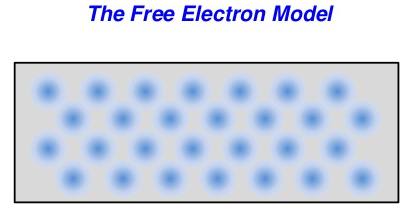
These "like" structural spatial placements of sub-atomic or atomic particles, atoms in COHP developed not for real analysis and modeling as seems this one. COH physics don't have - did not accept the structural HSP definitions of the sub-atomic physics objects - we tell on this for many years and in many works [3-29,32-39]. No - it is just to show students the mythical picture that could imitate the locations of the particle - but not for modeling this 3DD spatial physics.
Also of tremendous interest on this matter are works of prof. R.M.Santilli [30], for example, those to some extent with the some outdated (Homogeneous One-scale) physical reasonings in the remarkable arguments on falsified contemporary cosmology scams [31].
Among the Heterogeneous Two-phase media Many-body problems, for example, one can find the following
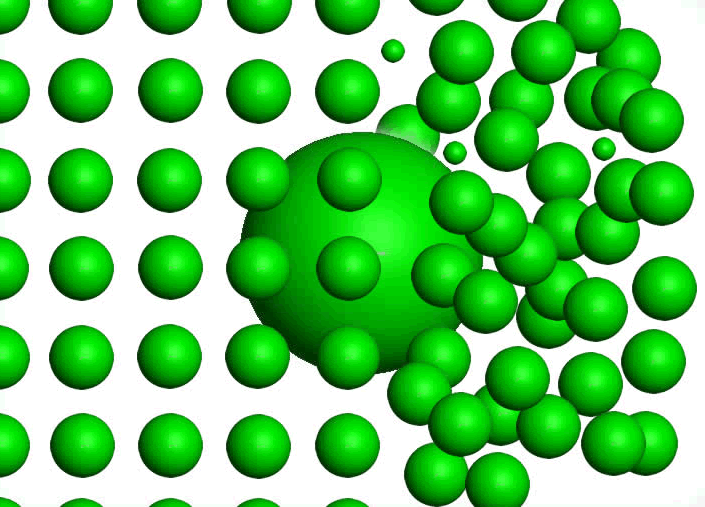
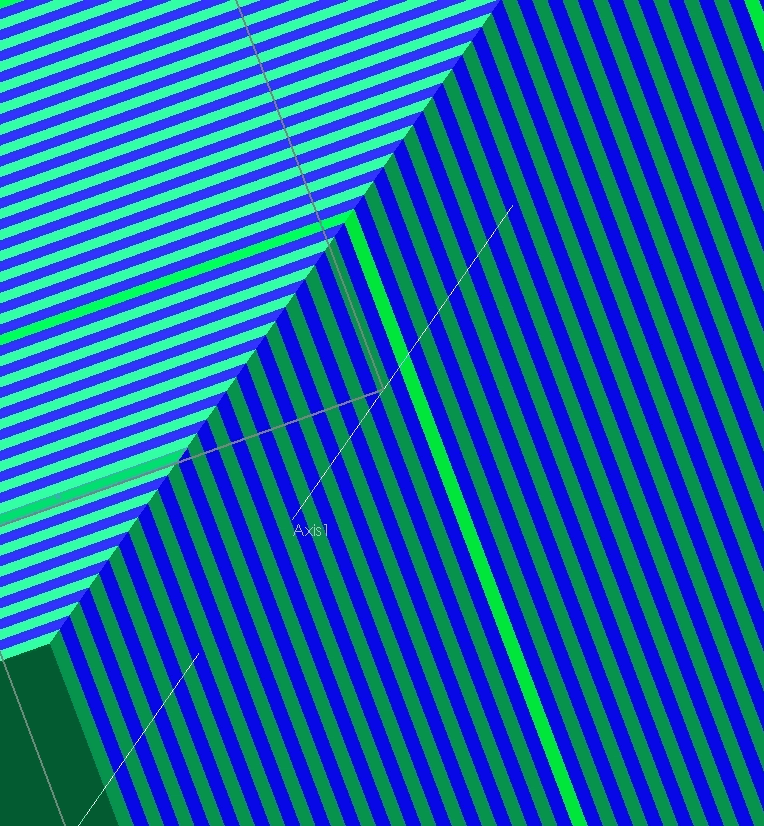
Oh, yes, this last one is also the Many-body problem - in the 1D Two-phase Two-scale statement, while one of the phases can be taken as the medium of the aether. Even if not the aether is the second phase - it is still the Many-body problem - just in COHP physicists don't know -What is the physics of Many-body problem - and construct the mathematical only explanation of the one-phase-one scale statements.
According to general points of view the new opinions or theories should be supported to some degree with the irresistible reasons and the math. Well, the math is all over this and other our publications - to provide it in a one chapter is above the normal delivering of the physical stuff and it is actually within the referenced publications.
We found the Two-scale Two-phase solutions after more than a century of incomplete and mostly incorrect one-phase-one scale "pseudo-solutions" and most of them are in publication only in this website -
Travkin, V.S., "When the 2x2 is not going to be 4 - What to do?" "http://travkin-hspt.com/eldyn/WhatToDo2.htm, (2002-2004)
see also on the kinds of solved Many-body problem in
Travkin, V.S., "Classical Problems in Thermal Physics," "http://travkin-hspt.com/thermph/02.htm, (2003)
It is so pure prove of the interscale physics difference, even analytical HSP Two-phase Two-scale solutions of the One-scale classical problems that can be found solved incorrectly in any COHP textbook were achieved by magic. Later on that COHP professors just shut up their mouses and keeping silence on these Two-scale solutions since the 1990s.
Now again - What is the main difference in mathematics for a Homogeneous media and the Many-body globular and not only globular morphology media treatments? This is seen from the two Figures following - where it is shown that the Heterogeneous WSAM theorem that is the great analog of Gauss-Ostrogradsky theorem provides for the serious diversity that brings in the quite unusual and dissimilar HSP governing equations.


Meanwhile, we remind again to students and professionals that the two-phase and polyphase media physics and mathematical methods for them did not exist in XIX and at the first half of XX century.
And that the hiding of this development area in education was done on purpose after the WWII - just for keeping the physics of small scales with the same fundamental concepts and paradigms as it was developed at the beginning of XX. For the COH physics saving.
That is why even in Nuclear Orthodox One-phase Physics
the particles
are just continue to be as the Point-Mass-Charge-Spin (PMCS) objects
with exchange via another mythical particles - and with no any
intermedia, but "Emptiness" with "Electromagnetic" properties!
This is not taught in the universities and students don't
know about this.
A number of strong arguments for a vision on the subject and HS physics of interacting particles/bodies arrays have been already outlined in many our publications, for example, these are from the greatest future fields in physics - Spinning (Rotation) Physics Scaled (SPS) in our "Torsion" or Spinning (Rotation) Physics Scaled (SPS):
" 15) The presentation of spinning, rotating particles (sub-atomic first of all) in COHP and consequently in "Torsion" physics as the mythical point-mass-charge-torsion dots has been prohibiting the correct Heterogeneous, Polyphase vision and treatment of the problems in physics of rotating particles (even of Continuum Mechanics scale) that have dynamics of movement in the volume filled with the aether or other substance, but not with the "quantum vacuum" widely used in COHP or the "physical vacuum" that has in COHP also the incomplete description of "nothing" with ability to create the sub-atomic particles. Up to these days students are fooled with books on "quantum vacuum" priced in tens of dollars?
These latter "vacuums" are not the substances or media in COHP, there is no interaction between those and sub-atomic particles, so the particles are hanging, moving within the "nothing" with some electromagnetic properties while having the "action-at-a-distance" between themselves throughout the "nothing" and with pretty simplistic or simply wrong the Lorentz force formula, etc.
By the way - the Lorentz force formula can not be generalized for multiple particle interaction correctly in COHP "Electrodynamics 2 - Elements 3P" just because COH physics doesn't know how to do this ?
There is no intermedium, the particles are the point-mass-charge-rotation(?) objects and there are no tools, methods, Heterogeneous mathematics in COHP for this task.
The "methods" that are in use in COHP as with the Lagrangians or the Hamiltonians that are defined locally, and as the known interactions are totally reducible to local-differential and potential treatments are not applicable to the issues on collective interactions and should be left to the XVIII century that they came from.
While COHP physicists cannot confess on this "top secret" shame, sorry for reminding.
The various theories of aether recognize at least that this is the substance with not known so far many characteristics. Nevertheless, acceptance of the aether as a substance with some known features justify at present all the physics of known mostly experimentally Spinning (rotating, but not twisting) particles dynamics and interactions within the scale of interest as well as between the scales and up to a Continuum scale.
The properties of physical effects allegedly considered as of the Spinning physics related and associated other necessary physical effects (3P as magnetic, electric, gravity) can be found, theorized, studied experimentally and modeled now in a mathematically correct way."
Only the application of HSP techniques, methods allow to observe the number of problems that can be formalized as the unified chapters in physics and mathematics of Many-body problems by some features, issues similar or the same as in others among the Polyphase Two-scale (at least) problems.
The sub-division in the sets of formulations and mathematical statements of Many-body problems can be drawn between the few groups.
1) One scale. Characterized as the simple XVIII century straight one scale tasks. Only the separate bodies, particles with no specified volume, morphology and surface features or the Point-Mass (PM) objects are present in the mathematical statement. Only the interaction equation(s) assigned and determined for pairwise interaction.
No interparticle medium and processes are allowed and described.
Example is actually the source problem: Gravidynamics inside of the solar system when the cosmic space filled with the aether - later in XX century it started as to be present as the vacuum without any properties. So - the problem formulated as - for just the distance and trajectories between the planets and sun and their dynamics equations.
Old style one phase Many-body problems of XVI-XVIII centuries. There is no sense even to discuss the mathematical piculiarities and long history of attempts to solve this kind of Many-body problem statements like for "physics" needs - because physically they are incorrect due to one-phase mathematical formulations, while mathematically these problems are not fully solved even at our times beginning of XXI.
2) One scale problems set up as in the above class, but the second medium with the equation(s) of processes is allowed. Meaning that the process(s) in the interparticle medium are recognized also as the physical process(s) with their governing equations. Still, it is the one-scale COH physics of the after the WWII time scale.
So - these are the two-phase problems with the one phase - the particles (bodies) with their inside physics. Mostly we mean the rigid Continuum body or particle, but not exclusively. And the intermedium is physically connected to the particle phase via the interface surface physics - the Boundary Conditions (BC) between them, but the BCs in these COHP Many-body treatments have not involved in the scaled physics and as we know this now - after more than 30 years of HSP developments - this blindness regarding the scaled physics do not allow to see and have in the problems many additional physical phenomena .
Examples are: the two-phase media - which are the most spread media in the universe probably - and the two-phase separate phases physics dynamics governing equations of a one scale as this is treated in COHP - with errors in the governing equations, by the way [32-39].
3) The Two-scale physical and mathematical description of physical nature of the two-phase and polyphase media of transport (transduction) of particles (many-body phenomena) when the dominant direction of physical processes is happening from the Lower scale physics to the Upper Scale physics - the Bottom-Up (BUP) Physics.
That means the Lower Scale BCs play one of the major roles in these problems. This part of HSP tasks description is the most advanced throughout the last 50 years of reasearch, see some of many examples of studies on HSP problems in different sciences [3-29,32-39] with references to other numerous studies.
Meanwhile, the most of physical science communities prefer not to respond to these challenges stated with HSP - because that means the great transfer in most of their wrong studies and actually conversion to a graduate level studies, examples [33-39].
Examples are: Distribution of mass- and/or energy (heat) within the porous medium throughout the porous networks. Numerous designs of chemical reactors and other heat- and mass transfering heterogeneous devices. Similar to spatial structures of Many Body medium morpholodies.

"Elementary" Particles in Space (Aether) Schematic. Note that here depicted the particles - not the "point-particles." That is why they can be compared to small balls, circles, tores, etc. That is allowed only in HSP - not for COH physics, because for COHP it is wrong and is the falsification of public and students.
The "Point" particles have no volume, surface and are not Visible - that is why they shoud be drawn as the Arrows showing the location of the "point-particle" and nothing else.
The related mathematical physics' for the "point-particles" be presented by only arrows for their coordinates and direction of movement and for the real volumetric particles and bodies are Different, quite different.
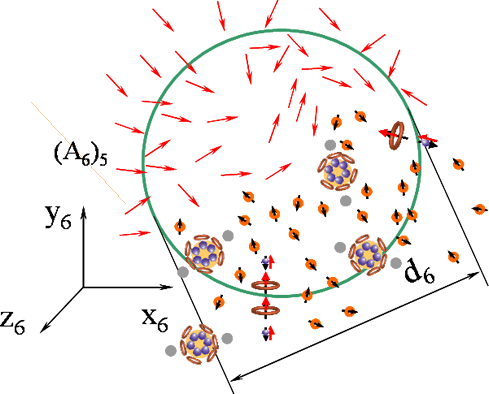
Two presentations of Volume with water molecules in paramagnetic state at the sub-atomic Fifth (A5)4 and Sixth (A6)5 zoomed scales distribution of free electrons, atoms of H, H2O, and ions in the aether in the low pressure vessel, for example. The Sub-atomic particles, atoms, and molecules of H2 and water given not in correct scales in the figure, but to visually present the real physical model for mathematical modeling that in COHP absolutely has been screwed since the beginning of XX century.
Here specifically at the Upper part of the figure the sub-atomic particles and even the atoms and molecules as usual in COHP designed as the Point-Mass-Charge-Spin (PMCS) objects -- so they need to be also graphically Invisible as in the COHP theories suggested and used in XX -- XXI and should be drawn by arrows pointing out only to location and not any structural or morphology features of particles.
On the contrary in the HSP presentation of the Lower part of the REV image is given much more complex physical model that now in XXI can and should be mathematically modeled and simulated.
For this real picture even the two-scale assessment COH physics can not perform.
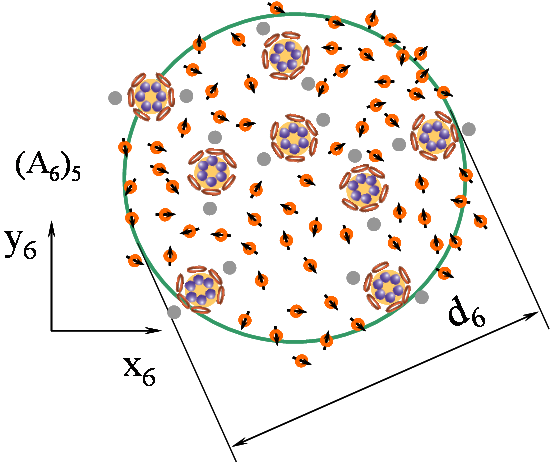
Modeling of water (HSP-VAT) in a REV as a bunch of molecules and some other particles as electrons in aether as the interactive medium. This is the three- or five-"phase" medium with no pair-wise potentials, but interactive EM Galilean and particles and aether's dynamics fields of course.
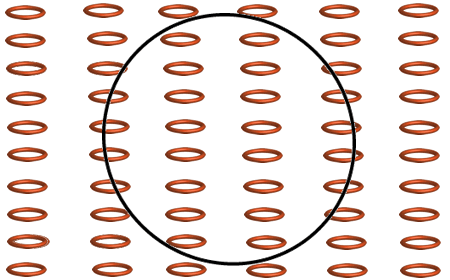
An array of ordered electrons in dynamics. To theorize and model this array the COHP methods are artificial, so the modeling of particles swarm in particle accelerators is pretty simplified, while dynamics equations are incorrect - see our analyses, texts, papers in relevant chapters-sections in this website (references below) and elsewhere.
The hydrogen gas properties can be shown have obvious and straightforward definitions and models for their simulation, while we can shortly address the existing homogeneous theories (homogeneous by nature of accepted methods for gaseous medium as being homogeneous in COHP for actual heterogeneous polyphase (at least three phases - gaseous molecules, CMBR and an aether) problems of gaseous media in a volume).
-on468x280.gif)
Hydrogen molecules at moderate temperatures and pressure - hydrogen gas (ortho- and para-hydrogen molecules) in a volume.
4) The Two- or more scale physical problems when physical and mathematical processes/methods and descriptions of transport (transduction) of particles (many-body phenomena) are directed from the Top- to Down scales (TDP) by scaled Physics. The boundary conditions at the Upper scale are the specific BCs.
Examples are: Polyphase media (particles, many-body phenomena) transport, dynamics, polyscale materials dynamics, transport in some environment or device, Heat Exchangers, some types of Chemical Reactors, External parts of Nuclear Reactors, etc.
The great role in this can be played by the possible determination of the (-1Sc) Scale - the Lower Scale which is below the Lower (0Sc) scale of the two-scale initially determined (developed) statement.
Meaning - if at the scale (0Sc) both phases are accepted as the Continuous matter physical statements - then if we admit that one or both these phases are not the initially considered as continuous matters - but itself (themselves) is the polyscale matter.
Also, we can accept that the scale (-1Sc) or Sc{(-1)} is formed of the 2 (for example) or more sub-phases.
Then we can talk on the Reverse construction of the scale (-1Sc) and scale (0Sc) corresponding process governing equations of the Top-Down GE development.
One of the main issues on this road would be the development, formulation of the Lower scale (-1Sc) the governing equations if they are in need. The problem right now is that when formulating the Lower scale (0Sc) governing equation(s) for each acting phase of the Heterogeneous medium we accept as the given assumption - that each Lower scale (0Sc) phase is the Homogeneous Continuum medium phase. While this definitely can be incorrect and mostly incorrect for the physical materials even for like Homogeneous Continuous structure at an initial scale [40-51,7].
The saving method (one of) in this situation is a call for the connecting coefficients - that is serving to science, and not only to physical sciences, for more then two hundred years. The largest technical science is the science of getting a needed coefficient [7].
Meanwhile, it is not only the problem with coefficients from the Lower scale Sc{(-1)} - but the many disappointed questions appear regarding the lost of new physical meaning terms in equations of both (0Sc, 1Sc) scale [3-29,32-39,40-51].
The meaning, the physical phenomena that these terms express are the new, sought after ones and these are of natural effects, that usually in the governing COHP equations on (0Sc) are of the forceful insertion, introduced mode on the base of outside thoughts following the Homogeneous studies used on the phenomena [7-10,13.37-39].
5) The Two, three or more scales physical processes or phenomena of transport (transduction) of particles (many-body) phenomena when the BUP and TD (BUP - TDP) physics scaling communications are happening simultaneously in the device or phenomenon.
These TD - BU physical and mathematical processes, phenomena are more complex and demanding for the accurate, more ratious formulation of physical and mathematical models, governing equations. The processes' general direction can be dominant TD or BU that actually demanding the different governing mathematical modeling equations.
All biological living creatures present themselves the examples of Double Transduction (Scale transport or transport of material and aetherial particulate natural components) BU- TD transport processes [52-65].
In a tedious selection and analysis of works by biologists and medical personnel [54] we reflected on some good intended studies where workers do understand importance of studying the real biological, medicinal issues with the most close morphological copying of tissue samples, parts of organs or biocells as, for example, in the very resourceful work with COHP fake Scaled (!) presentation of ensemble of cell's Nuclear Pore Complex, where are given figures with Heterogeneous bio-tissues as this one
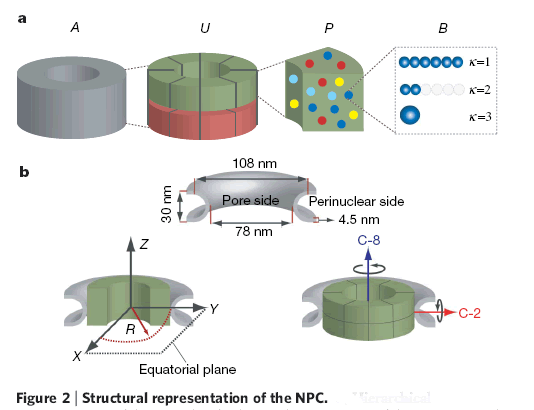
The real Hierarchical structure of the cell's Nuclear Pore Complex (NPC) - consisting of four (4) scales with different structural and physical functions - the great mortal error is depicted on the third scale P with the Figure (P) for 3D structure of molecules - they are still drawn as in the Homogeneous block with molecules. And besides - the three other scale selected Volumes for analysis are also the Heterogeneous Polyphase Volumes. Workers just don't know how to make a figure and treatment - research of Polyphase volumes here in openly biophysical study - still in usual pictures in medicinal literature doctors know how to draw the piece of Polyphase tissue. So far described in a pure biological semantical language. Meanwhile, in HSB Each scale has components of physical description and mathematical language and models. These models are not and would not being available to biological communities - unless they handle somehow HSB education and tools.
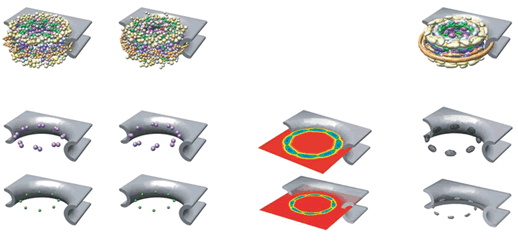
The parts and assembling the NPC of large sub-parts of macromolecules.

Cellular NPC assembled from the macromolecules and shown at the Upper scale. The function and properties of NPC as a whole and of parts are not achievable and available for description and analysis for this One-scale Homogeneous biological model - the Many-body problem in biology.
Our comments:
The text statements and the Figures in the paper tell us about the pure need for scaled representation and solution in terms of hierarchy of the structure and the function of the NPC. Nevertheless, in the study there is no really hierarchical model building -- presented a morphological construction of the NPC. That is a desirable, but the "fake" hierarchy Top-Down. While authors can not present and do the Bottom-Up sequence - that is the primary goal to understand the FUNCTION of NPC.

Three scale resolution and Transduction of Properties - Scaleportation in a water polyphase-polyscale solution.
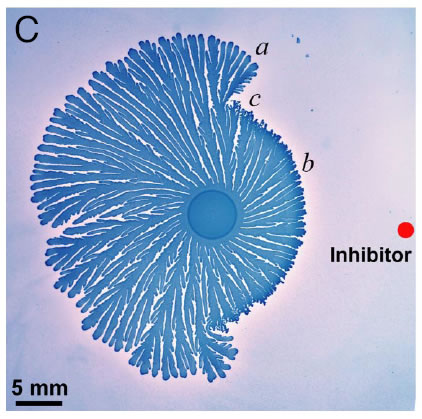
Growing of bacterial colony in a nutrient solution with an inhibitor. The Many-body problem in bacteriology.

Polyphase-Polyscale-Polyphysics (3P) blood dynamics in a middle size capillary - the Many-body problem in medicine.
==================================================================
Any ecological system of small or large (even global) scale is the Double Transduction TD - BU transport and cannot be stable on the large time frames due to primary influence of astronomical events.
It is interesting to watch the same kind of "none-intersect" tricks in the biology and medicinal publications that professionals in these fields have learned from the COH physics community.
That means in any picture or figure drawn in biology and medicinal publications the bounding surface or line SHOULD NOT intersect (cross) the second or other phases in the Polyphase media which are normal in biology and medicine. This rule for Homogeneous only media they know.
But what to do when the media
Should be crossed - and them anyway should be - otherwise the study doesn't worse a paper it published on - workers don't know.
See students these "innocent" like scams in our:
Travkin, V.S. and Bolotina, N.N., "Analysis of Current Studies on Scaled, Collective Phenomena in Medicine Fields Presented as the One-Scale Concepts ," "http://travkin-hspt.com/med/medpapers/medpapers.htm (2013)
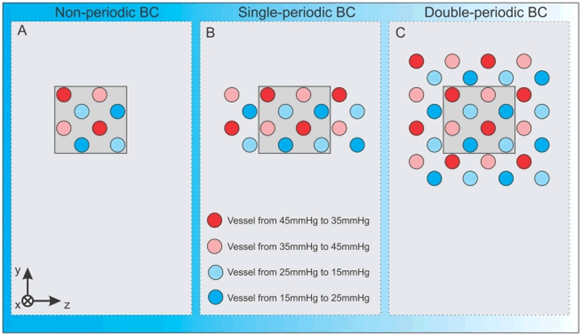
"Figure 9. Multi-vessel basic vascular unit. A) A basic parent vessel unit that includes eight vessels with equal pressure differences, but with four different mean pressures, arranged so that the nearest parent vessel in each case is at a different mean pressure, which should enable functional vessels to form within and between subdomains. Non-periodic means that we consider reflection boundary conditions in all directions. B) Periodic boundary conditions in the z-direction. C) Periodic boundary conditions in the y- and z-directions."
Our comments:
This is the error that will be placed in the encyclopedias of biology, physics and mathematics - How the Homogeneous description of biomedia and problem in them are different from a Heterogeneous Scaled (at least two scales) polyphase models (correct ones).
The "solutions," simulations of the problem stated as this are not worth to consider as such while the initial concepts and mathematical statements are incorrect.
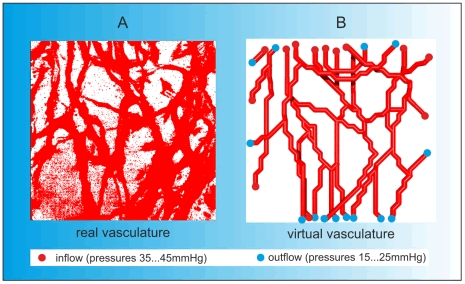
"Figure 13. Image reconstruction. We reconstructed the vascular network by applying the following strategy. 3D multiphoton fluorescence microscopy images (A) taken from mouse models in vivo formed the basis of our geometrical reconstruction. These images were transferred to OpenInventor and Matlab for image analysis. Based on the data we reconstructed the vascular graph model that describes the connectivity of the vascular network. B) We assigned inflow (red points) and outflow nodes (blue points) at various pressures in order to obtain a persistent and stable network. The vascular graph is characterised by the spatial coordinates of the nodes and the connections between them."
Our comments:
Here in this medicinal biophysics example is drawn the model that workers don't understand - How to tackle it?
Because in this model the blood flow is crossing the Bounding surfaces for considering the phenomena and modeling them.
Any mathematical model developed in COH physics, biophysics
for this task will be
wrong - the wrong spending of human and other resources.
Note -- that there is the one only phase being intersected by the boundary surfaces of the REV!
On purpose? What is the purpose of keeping one only phase divided by bounding surfaces?
One of another examples group is the nuclear reactors core function [66-71] when physics of the sub-atomic scales is the first hand BU (Bottom-Up) dominant physical mechanism and at the same time the influx of cooling component is the TD (Top-Down) influences upon the core of a reactor.
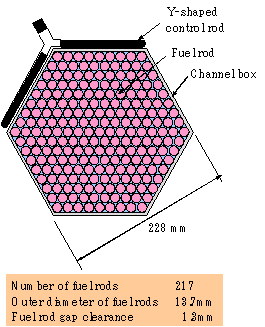
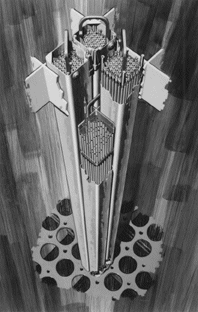
The mysterious for COHP free energy (energy from the aether mainly) devices, generators are also the type of BU- TD mass-energy transporting devices [40-51,72-75].
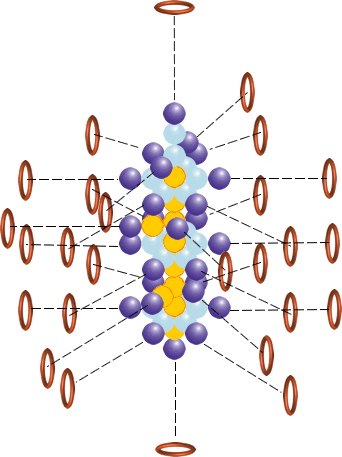
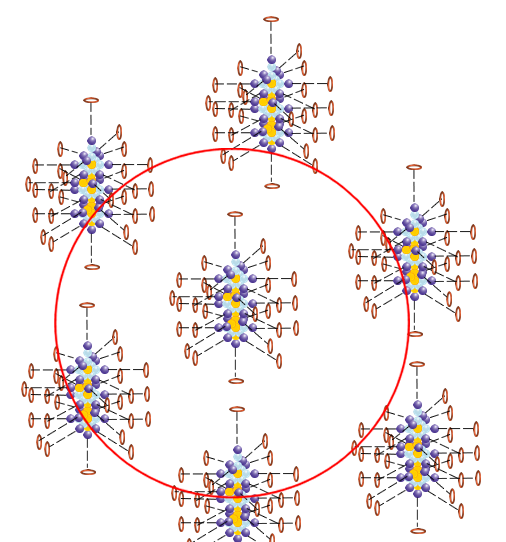
Scaled (some of) presentations and modeling of Fe^56 as a single atom and in the aether (HSP-VAT) averaging in a REV as of a bunch of interactive atoms.
This is to illustrate that physics (HSP) is more complicated than COHP's the gang of just charged points-mass'. The scales here are for depiction of the ideas, not the real scales.
Magnetic Motors by M.Yildiz are due to spatial arrangements of magnets [45-51]:
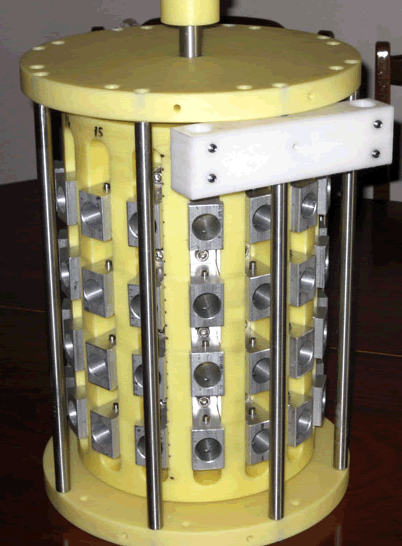
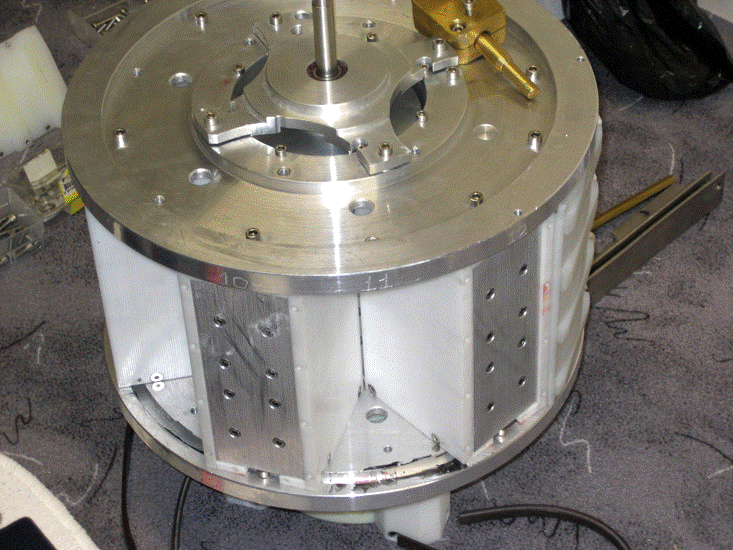
One of the final phases of A.Rossi Reactor's Nuclear Transduction [72-75].
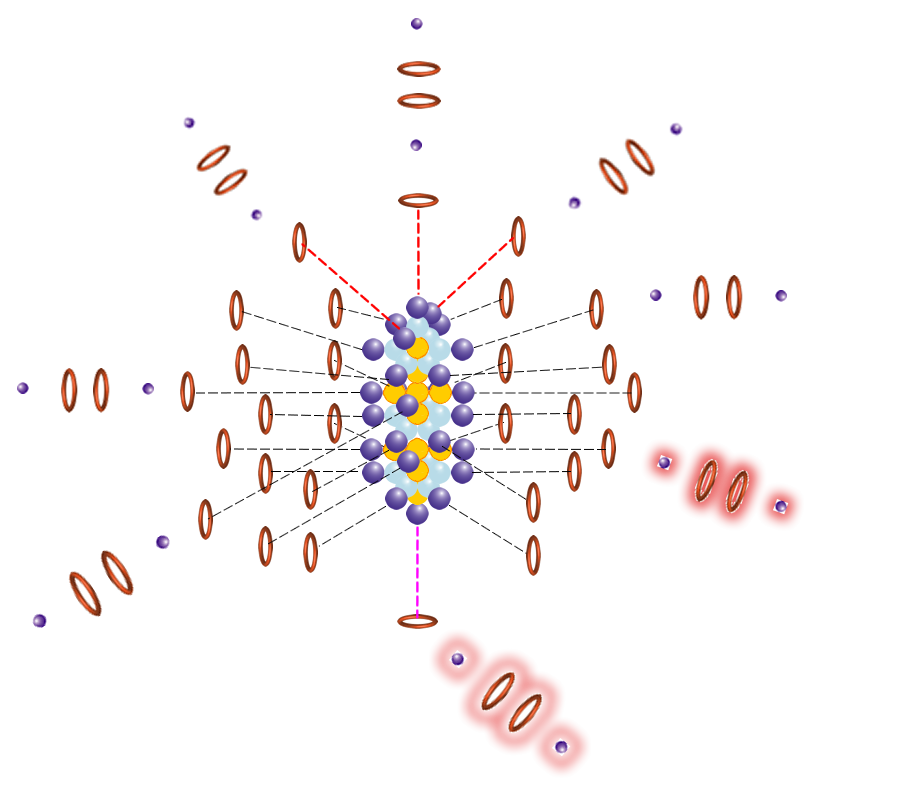
Nickel atom excitement in electromagnetic pulsing fields while ortho-hydrogen molecules explicitly interacting with Nickel's electrons. One of the scenarios in the chamber of reactor. Scales are for convenient observation only.
The following article will describe and explain in more specific and detailed HSP mathematical language for ascribed here physical models for Many-body problem phenomena, not just mathematical statements that might have concern to the problem, the Two- or Three-scale subjects regarding the "Physics of Many-body Particulate Media Problems. Not Only Mathematics. Physics 2."
Travkin, V.S., "Physics and Modeling of Many-body Particulate Media Problems - HSP," _** http://travkin-hspt.com/parphys2/manypartibodycl/manypartibodym.htm
Access to manuscript may be obtained for qualified parties. Apply for authorization.
1. "n-body problem," http://en.wikipedia.org/wiki/N-body_problem#Other_n-body_problems, (2015)
2. "Many-body problem," https://en.wikipedia.org/wiki/Many-body_problem, (2015)
3. Travkin, V.S., Catton, I., Transport Phenomena in Heterogeneous Media Based on Volume Averaging Theory, in Advances in Heat Transfer, Vol. 34, New York: Academic Press, pp. 1-144, (2001)
4. Travkin, V. S., What's Wrong with the Pseudo-Averaging Used in Textbooks on Atomic Physics and Electrodynamics for Maxwell-Heaviside-Lorentz Electromagnetism Equations, http://travkin-hspt.com/eldyn/maxdown/maxdown.htm, (2009)
5. Travkin, V. S., Incompatibility of Maxwell-Lorentz Electrodynamics Equations at Atomic and Continuum Scales, http://travkin-hspt.com/eldyn/incompat/incompat.htm, (2009)
6. Travkin, V. S., Electrodynamics 2 - Elements 3P (Polyphase-Polyscale-Polyphysics), http://travkin-hspt.com/eldyn2/index.htm, (2013)
7. Travkin, V.S., Experimental Science in Heterogeneous Media, http://travkin-hspt.com/exscience/index.htm, (2005)
8. Travkin, V.S., "What Classical Mechanics of XVIII Provided in XX Has Done Wrong to the Base of Mechanical Science Including the Classical Mechanics of Continuum Particles and Conventional Orthodox Homogeneous Particle Physics", http://travkin-hspt.com/rottors/classmechwrong/classmechwrong.htm, (2014)
9. Travkin, V.S.,"The Major Forces Have Been Missing From Governing Equations for Dynamics of Sub-atomic and Continuum Particles, Bodies in XVIII - XX ", http://travkin-hspt.com/rottors/forcemissing/forcemissing.htm, (2014)
10. Travkin, V.S., "Classical Mechanics Attempts for Description of Atomic Physics (ClM One-scale One-phase Homogeneous Atomic Physics - ClMO2HAP) Phenomena ," http://travkin-hspt.com/parphys2/clmechonesc1/clmechonesc1.htm, (2014)
11. Travkin, V.S., "Spinning or "Torsion" Mechanics in "Homogeneous" Media? Is it Possible?" http://travkin-hspt.com/rottors/torsmechhom/torsmechhom2.htm, (2015)
12. Travkin, V.S., "Scaled Presentation of "Torsion" Mechanics in Polyphase Media", http://travkin-hspt.com/rottors/tormechpoly/tormechpoly.htm, (2014)
13. Travkin, V.S., Experiment of Franck-Hertz on Electron Scattering in a Mercury Vapor. Physics 2 , http://travkin-hspt.com/atom2/franckhertz/franckhertz.htm, (2014)
14. Travkin, V.S., Particle Physics - Heterogeneous Polyscale Collectively Interactive, http://travkin-hspt.com/parphys/index.htm, (2011)
15. Travkin, V.S., "What is the Particle Physics Now?" http://www.travkin-hspt.com/parphys/whatispp/whatispp.htm , (2011)
16. Travkin, V.S., Particle Physics (Particle Physics 2). Fundamentals, http://travkin-hspt.com/parphys2/index.htm, (2013)
17. Travkin, V.S., Nuclear Physics Structured. Introduction, http://travkin-hspt.com/nuc/index.htm, (2006-2013)
18. Travkin, V.S., Statistical Mechanics Homogeneous for Point Particles. What Objects it Articulates? http://travkin-hspt.com/statmech/index.htm, (2014)
19. Travkin, V.S., Solid State Polyscale Physics. Fundamentals, http://travkin-hspt.com/solphys/index.htm, (2014)
20. Travkin, V.S., Atomic and Subatomic Physics 2 - Elements 3P, http://travkin-hspt.com/atom2/index.htm, (2003-2015)
21. Gordienko, Y.G. and Travkin, V.S., "Transport Properties of Point-Like Objects in Multi-Scale Heterogeneous Substructure," http://travkin-hspt.com/atom/pointlike.htm, (2003)
22. Travkin, V.S., "Crystalline Medium Defects and Micro-Heterogeneous Solid State Plasma VAT Equations," http://travkin-hspt.com/atom/04.htm, (2004)
23. Travkin, V.S., Elements of the 2nd Physics at the beginning of XXI , Elements of the 2nd Physics at the beginning of XXI, (1980-2015)
24. Travkin, V.S., "Two-Scale Three-Phase Regular and Irregular Shape Charged Particles (Electrons, Photons) Movement in MHL Electromagnetic Fields in a Vacuum0 (Aether)," http://travkin-hspt.com/parphys2/abstracts/twoparticlesshort-ab.htm, (2011)
25. Travkin, V.S. and Bolotina, N.N., "Two-Scale Two-Phase Formation of Charged 3D Continuum Particles - Sphere and Cube From Electrons in a Vacuum0 (Aether). An Example of Scaleportation of Charge from the Sub-Atomic to Continuum Charged Particles, Conventional MD Cannot be Applied," http://travkin-hspt.com/parphys2/abstracts/subtocontin-ab.htm, (2011)
26. Travkin, V.S. and Bolotina, N.N., "One Structured Electron in an Aether (Vacuum0) Electrodynamics, Many Electrons in an Aether Fixed in Space - the Upper Scale Galilean Electrodynamics," http://travkin-hspt.com/parphys/abstracts/stillelectrons-ab.htm (2011)
27. Travkin, V.S. and Bolotina, N.N., "Electrons and CMBR (Cosmic Microwave Background Radiation) Flux of Photons in a Vacuum0 (Aether) - Two-Scale Galilean Theory ," http://travkin-hspt.com/parphys/abstracts/elcmbr-ab.htm (2010)
28. Travkin, V.S. and Bolotina, N.N., "The Classical and Sub-Atomic Physics are the Same Physics," http://travkin-hspt.com/parphys/pdf/51_PrAtEd-QM-Ref-2HSPT.pdf, (2013)
29. Travkin, V.S., Scattering Modeling in Optics using One Scale , http://www.travkin-hspt.com/optics/optscattering.htm, (2003-2008)
30. "Institute for Basic Research," http://www.i-b-r.org/index.htm, (2015)
31. Santilli, R.M., "Interview of prof.. Ruggero Maria Santilli on the Ongoing Obscurantism in Cosmology," http://www.i-b-r.org/Prof-Santilli-Interview.html, (2013)
32. Travkin, V.S., "Concepts: HSP-VAT Conceptual Vision and Methods in Application to Continuum Mechanics," http://travkin-hspt.com/elastic/conceptscm/conceptscm, (2010)
33. Travkin, V.S., "Are there any other Methods and Theories available?" http://travkin-hspt.com/fundament/04.htm, (2001)
34. Travkin, V.S., "Reductionism and/versus Holism in Physics and Biology - are Both Defective Concepts without Scaleportation," http://travkin-hspt.com/fundament/scaleport/scaleport.htm, (2005)
35. Travkin, V.S., "Pseudo-Averaging (Scaling, Hierarchy), Quasi-Averaging, Ad-hoc Averaging, and other "Averaging" (Scaling, Hierarchy) Type Claims," http://travkin-hspt.com/, (2002)
36. Travkin, V.S., Continuum Mechanics of Heterogeneous (Ht) Media; Elasticity, Plasticity, http://travkin-hspt.com/elastic/index.htm, (2005)
37. Travkin, V.S., "What is in use in Continuum Mechanics of Heterogeneous Media as of Through ~1950 - 2005?" http://www.travkin-hspt.com/elastic/whatsupf/whatsup.htm;, (2005-2006)
38. Travkin, V.S., "Who Are in the Continuum Mechanics Continuing to Dwell in an Ivory Tower? Who Tries to Re-Invent the Wheel? What Are the Damage and Financial Loss?" http://www.travkin-hspt.com/elastic/ivorytower/ivorytower.htm, (2006)
39. Travkin, V.S.,"Homogeneous Mathematical Schemes for Heterogeneous Multiphase Fluids - 14 Years After 1998 Analysis and Criticism, " http://travkin-hspt.com/fluid/homofluids2012/homofluids2012.htm, (2012)
40. Travkin, V.S., "Papp Effect is a Nuclear/Atomic One," http://travkin-hspt.com/nuc/abstracts/pappeff-ab.htm, (2010)
41. Travkin, V.S., "Isomers in Conventional Orthodox Homogeneous Nuclear Physics (COHNP) and in Reality," http://travkin-hspt.com/nuc/abstracts/isomers-ab.htm, (2014)
42. Travkin, V.S., "Transfer of Energy Up and Down within the Isomer's Nucleus Structural Formula Domain," http://travkin-hspt.com/nuc/abstracts/isomenergy-ab.htm, (2014)
43. Travkin, V.S., "Pumping of Energy by Noble Gases. Papp Engine Function," http://travkin-hspt.com/nuc/abstracts/pappenergy-ab.htm, (2014)
44. Travkin, V.S., "Interscale Magnetism Between the Sub-Atomic ("vacuum0") - Mesoscale (Continuum) - and Bulk Micrometer Scale Polydomain Characteristics. Magnetic Motors Phenomenon Applications," http://travkin-hspt.com/fermag/abstracts/magnet3sc-ab.htm, (2013)
45. Travkin, V.S., "02//2013 Are Magnet Motors (MM) Exist? Misunderstanding of the Function," http://travkin-hspt.com/fermag/mmexist/mmexist.htm, (2013)
46. Travkin, V.S., "02//2013 Failure of Perendev and V-gate MM Homogeneous Designs (Homogeneous Models Do not Exist). Then the Scaled Approach," http://travkin-hspt.comfermag/failPerendev/failPerendev.htm/, (2013)
47. Travkin, V.S., "02//2013 Magnet Motors of M.Yildiz. Major Design Polyscale Features and Solutions. Why These MM Work?" http://travkin-hspt.com/fermag/yildiz1fl/yildiz1fl.htm, (2013)
48. Travkin, V.S., "Upscale Energy Transport in Magnet Motors (MM) from the Sub-atomic to the 2-nd Heterogeneous Continuum Scale in MM ," http://travkin-hspt.com/fermag/abstracts/mmenergyup-ab.htm, (2013)
49. Travkin, V.S., "Electromagnetic Fields of Electrons and Atoms of Fe, Cu, and Ni at the Sub-Atomic and a Single Site of Perfect Crystal Lattice," http://travkin-hspt.com/fermag/abstracts/emelectronfecuni-ab.htm, (2013)
50. Travkin, V.S., "Rotation of Fe and Cu Atoms in a Crystal Lattice Induced by External Electromagnetic Fields ," http://travkin-hspt.com/fermag/abstracts/rotationfecu-ab.htm, (2013)
51. Travkin, V.S., "Evaluation of Magnetic Fields and Magnetization of Fe and Cu Atoms and Their Continuum Solid State Plates at Various Temperatures," http://travkin-hspt.com/fermag/abstracts/magnetizfecu-ab.htm, (2013)
52. Travkin, V.S., Catton, I., Porous Media Transport Descriptions - Non-Local, Linear and Nonlinear Against Effective Thermal/Fluid Properties, in Advances in Colloid and Interface Science, Vol. 76-77, pp. 389-443, (1998)
53. Travkin, V.S. and Bolotina, N.N.,Biology and Ecology as Hierarchical, Heterogeneous, Multiscale Sciences and their Applications, http://travkin-hspt.com/bio/index.htm, (2006)
54. Travkin, V.S. and Bolotina, N.N., How not to Scale-Down...or -Up.. ..Analysis of Current Studies on Scaled, Collective Phenomena in Biology Fields Presented as the One-Scale Concepts, http://travkin-hspt.com/bio/biopapersop.htm, (2009)
55. Travkin, V.S., "Concepts: HSP-VAT Conceptual Vision and Methods Applied to Biology," "http://travkin-hspt.com/bio/conceptsbio/conceptsbio.htm, (2013)
56. Travkin, V.S. and Bolotina, N.N., "The Tool Biologists Have Been Craving For Does Exist. The Issue Is Who Can Use It?" "http://travkin-hspt.com/bio/thetool/thetool.htm, (2013)
"The Tool Biologists Have Been Craving For Does Exist. The Issue Is Who Can Use It?"(938K)
57. Travkin, V.S. and Bolotina, N.N., "Principles, Biological and Mathematical Modeling For Elasticity, Poroelasticity of Soft Biomedia, Polymers with Fluids Mechanics in the Bioporous Two-scale Media," "http://travkin-hspt.com/biophysics/poroelastic/poroelastic.htm (2011-2013)
58. Travkin, V.S., Bolotina, N.N., and Gusev, A.L., "Presentation of Continuum Mechanics Elasticity Models for Heterogeneous Media. The Polyphase and Polydefect Scale Physics, Hierarchical Mathematics Applied," IS Journal of Alternative Energy and Ecology, No. 2, pp. 19-41, (2012)
59. Travkin, V.S. and Bolotina, N.N., "Quantum Chemistry, Physical Chemistry, Molecular Dynamics Simulation, DFT (Density Functional Theory), and Coarse-Graining Techniques Applied in Structural, Cellular Biology, Polymer Science and Implication for Scaleportation," Journal of Alternative Energy and Ecology, No. 2, pp. 58-75, (2011a)
60. Travkin, V.S. and Bolotina, N.N., "Pseudo-Scaled and Scaled Description and Scaleportation of Inorganic and Organic Polymer and Polymer Composites Properties," Journal of Alternative Energy and Ecology, No. 1, pp. 62-77, (2011b)
61. Travkin, V.S. and Bolotina, N.N., Heterogeneous Scaled Biophysics (HtScBp). Fundamentals, "http://travkin-hspt.com/biophysics/index.htm (2010)
62. Travkin, V.S. and Bolotina, N.N., Bacteriology Heterogeneous PolyScale (BHS), "http://travkin-hspt.com/biobact/index.htm (2005)
63. Travkin, V.S. and Bolotina, N.N., Cellular Biology HS ↑↓ , "http://travkin-hspt.com/biocell/index.htm (2009)
64. Travkin, V.S., Structural Biology Based on Homogeneous Physics (SBH) and Elements 3P (Polyphase-Polyscale-Polyphysics) of Structural Biology 2 (SB3P) - as Hierarchical, Heterogeneous, Multiscale Science, "http://travkin-hspt.com/biostruc2/index.htm (2014)
65. Travkin, V.S. and Bolotina, N.N., Virology - is the Heterogeneous Hierarchical Science ↑↓, "http://travkin-hspt.com/virology/index.htm (2011)
66. Travkin, V.S., "Nuclear Energy, Polyscale Polyphase Structure of Heat Generation. HtHr Modeling," http://travkin-hspt.com/nuclearen/index.htm, (2009)
67. Travkin, V.S., "Scaled Heat Transport in Composite Media of Fuel Rods, Pebble Beds in LWR and HGCR," http://travkin-hspt.com/nuclearen/fuelrods/fuelrods.htm, (2011)
68. Travkin, V.S., "Reactor Physics Transport Equations Currently are Accepted and Modeled as for Homogeneous Media!" http://travkin-hspt.com/nuclearen/reactor/reactor.htm, (2011)
69. Travkin, V.S., "Thermal-Hydraulic Coolant Transport, Reactor's Fuel Assemblies and Heat Exchanger's Transport Models are also Accepted as Homogeneous (Wrongly)," http://travkin-hspt.com/nuclearen/lwrmodels/lwrmodels.htm, (2011)
70. Travkin, V.S., "Fast Nuclear Reactors 3P Theory in HSNP and Engineering," http://travkin-hspt.com/nuclearen/fastnucleartheor/fastnucleartheor.htm, (2015)
71. Travkin, V.S., "Hierarchical Scaled Physics (HSP) Polyphase Energy and Heat Transport in LWR, HW, Tritium, and Deuterium," http://travkin-hspt.com/nuclearen/heatincoolant/heatincoolant.htm, (2015)
72. Travkin, V.S., "Hierarchical Scaled (HS) Particle Physics in Rossi's E-Cat Nuclear Reactor," http://travkin-hspt.com/parphys/abstracts/particlephysecat-ab.htm, (2012)
73. Travkin, V.S., "Two- and Three-Scale Polyphase (Local (Sub--Atomic) - Nonlocal) Galilean Electric and Magnetic Fields in a Solid and Nano-powdered Cu and Ni (Copper and Nickel)," http://travkin-hspt.com/parphys/abstracts/elmagincupnickel-ab.htm, (2012)
74. Travkin, V.S., "Gamma Photons in Rossi's E-Cat Nuclear Reactor and Real Heating Particles and Effects," http://travkin-hspt.com/parphys/abstracts/rossigammafun-ab.htm, (2012)
75. Travkin, V.S., "Top-Down and Bottom-Up Hierarchical Processes in the E-Cat Nuclear Reactor. Physics 2," http://travkin-hspt.com/coldlenr/ecathier1/ecathier1-ab.htm, (2012-2013)
============================================= =============================================
"Physics of Many-body Particulate Media Problems. Not Only Mathematics. Physics 2"
This is also the well known problem - still can not be resolved within the Homogeneous One-Scale General physics, Spinning physics, nuclear, particle and atomic physics, electromagnetism, Gravidynamics and astrophysics.
![]()

![]()